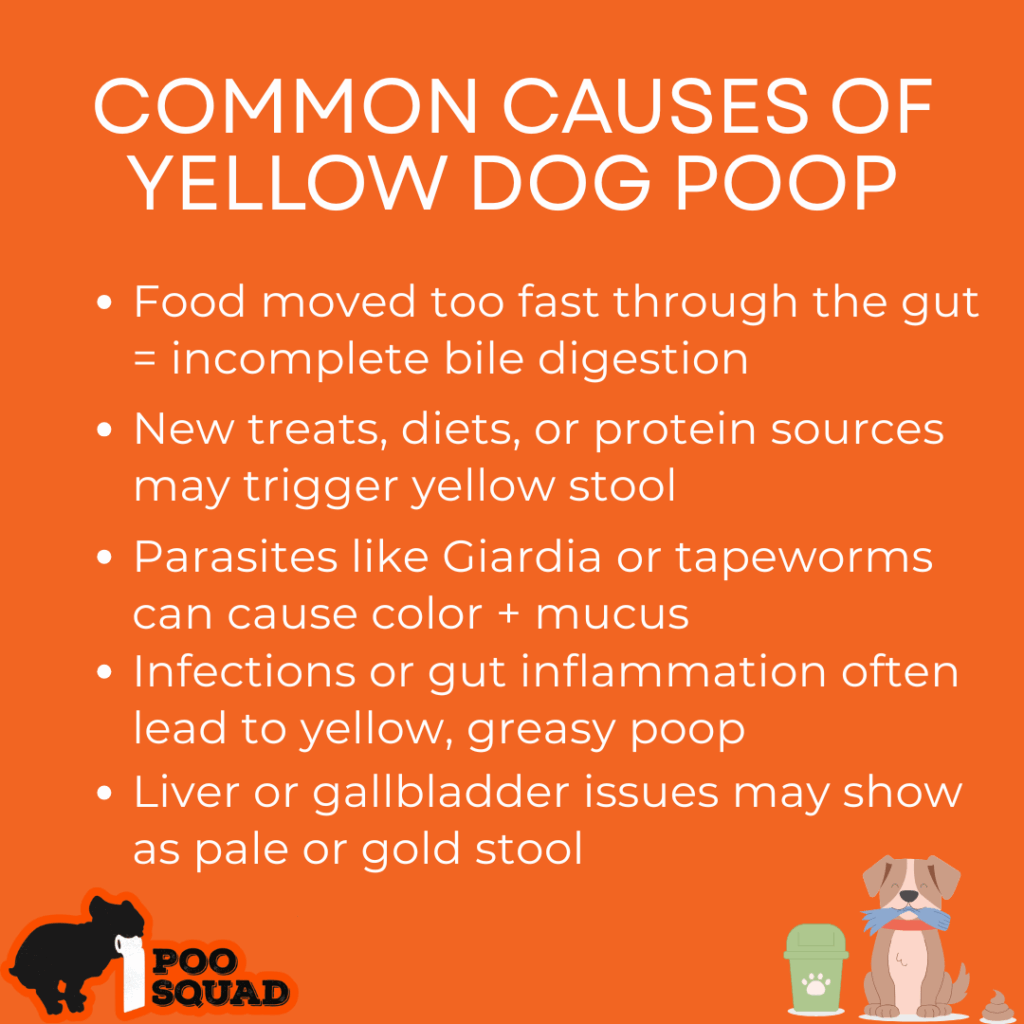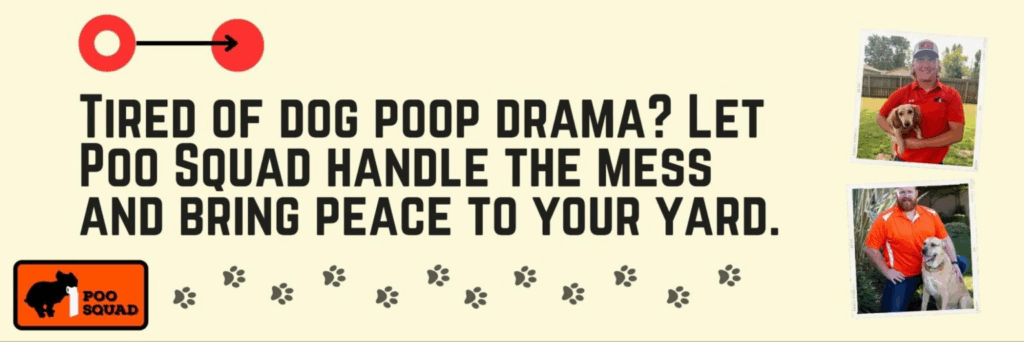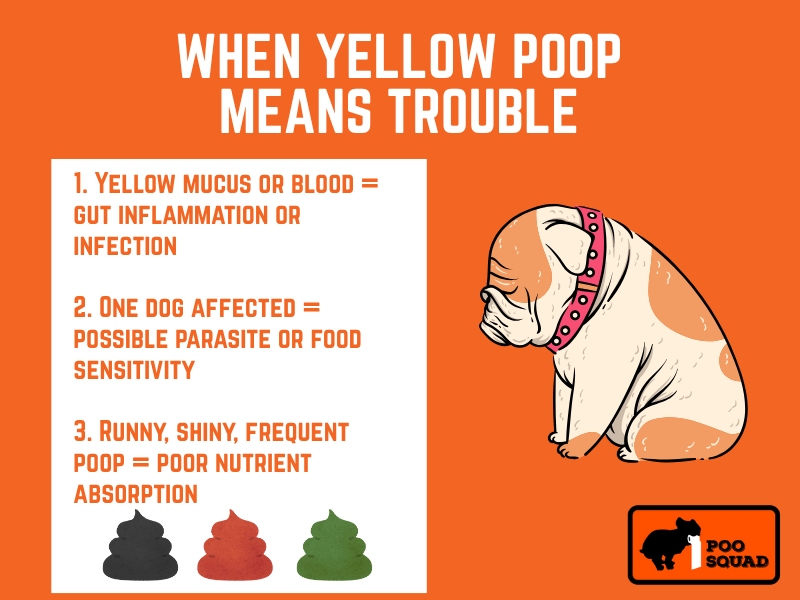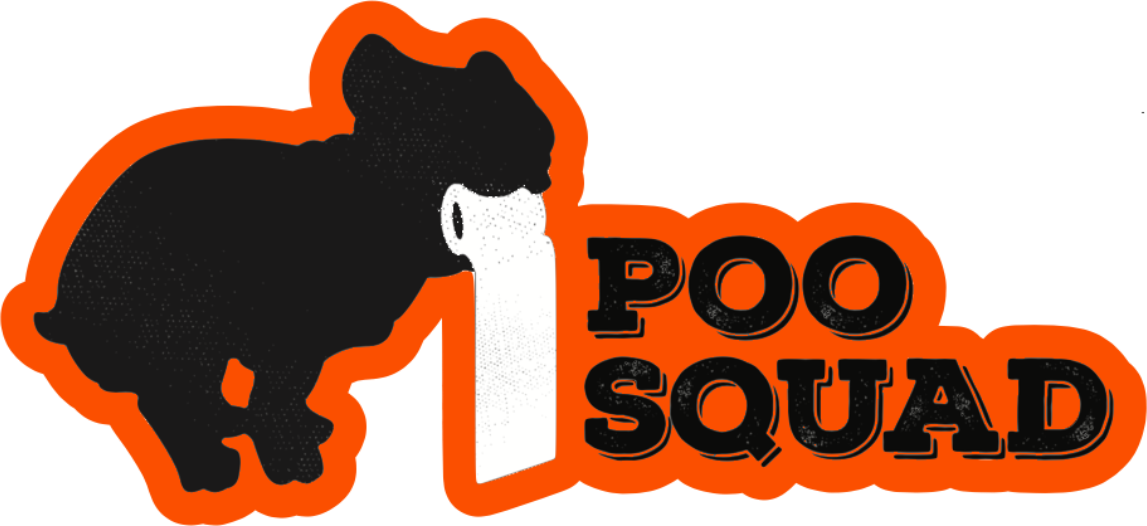Yellow dog poop often signals rapid digestion, food sensitivity, or bile imbalance. It may also point to infections, parasites, or liver issues, especially if it’s slimy, greasy, or recurring. One-off yellow stool is not always urgent, but repeated episodes need veterinary attention.
Yellow dog poop is not normal, and while not always dangerous, it’s a sign something’s off.
- Most commonly, it means food moved too fast through the digestive tract, preventing bile from fully breaking down.
- It can also indicate parasites, infections, or liver and gallbladder problems requiring medical attention.

As pet professionals who see thousands of yards a year, we’ve spotted everything from harmless food reactions to bright yellow warning signs that led to emergency vet visits.
- This is why we built color and texture notes into our Dog Poop Report Card, most pet owners don’t catch subtle changes until symptoms escalate.
Even if you’re looking at bright yellow puddles or streaks of yellow mucus, this post breaks down what it could mean, when to act, and what you can do at home to keep your dog safe.
If your dog’s poop looks wrong, even if everything else seems fine, pay attention. Their gut is talking.

Common Causes of Yellow Dog Poop
Yellow dog poop usually points to a digestive system that didn’t get enough time to process bile. But it can also mean your dog ate something funky, caught a parasite, or is reacting to food or meds. Knowing what caused it can save you stress and a vet bill.
1. Food Moved Too Fast Through the Gut
Normally, bile turns poop brown as it breaks down. When food moves too quickly, bile doesn’t finish its job, leaving behind a yellow tint. This can happen after a diet switch or a bout of tummy trouble.
2. New Foods, Treats, or Allergies
A sudden switch in food, a rich treat, or a protein your dog’s never had can all trigger yellow stool. If you’re adjusting their meals, go slow. Our Report Card flags patterns like this for customers all the time, especially during onboarding when diet changes are common.
3. Parasites Like Giardia or Tapeworms
Yellow diarrhea combined with weight loss, vomiting, or mucus may point to parasites. Tapeworms look like white or yellow rice grains in stool. Giardia can turn it runny, greasy, and gold-hued. If you’ve seen a sudden change and your dog is acting off, get a fecal test.
4. Infection or Gut Inflammation
Yellow mucus in poop usually means your dog’s intestines are inflamed, from bacteria, allergies, or even eating sticks and sharp scraps. We’ve scooped yards where this shows up, especially when dogs have a habit of dumpster diving or tearing into trash.
5. Liver or Gallbladder Trouble
When we notice yellow poop week after week, especially greasy or pale shades, we flag it. This can mean liver disease or a bile duct issue. If your dog’s skin or eyes also look yellow, call your vet right away.
6. Medications and Supplements
Iron supplements, antibiotics, or even certain joint pills can mess with gut bacteria and temporarily turn poop yellow.
This can show up days after finishing a round of meds, especially if probiotics weren’t used.
When Yellow Poop Is No Big Deal
Not all yellow dog poop is a red alert. We see plenty of harmless cases, usually tied to a food switch, a minor gut reaction, or something non-toxic they shouldn’t have chewed in the first place. If it’s a one-off and your dog seems fine, don’t panic.
1. One-Time Reaction to Food or Treats
Trying a new protein or giving a fatty snack can throw off your dog’s digestion for a day or two. If your pup’s acting normal otherwise, it’ll usually pass. Keep an eye on things for 24–48 hours and consider simplifying meals with a bland diet like boiled chicken and rice.
2. Stress or Travel
Dogs are creatures of routine. A move, loud thunderstorm, or even a change in walk times can mess with digestion. Some dogs respond to stress by skipping meals, which can also affect stool color. One user asked if anxiety could cause yellow poop, the answer is yes, it happens more than you’d think.
3. Ingested Non-Food Items
From tennis ball fuzz to pieces of chew toys, we’ve seen some strange things make their way out. Our teams have scooped up neon yellow poop that came from nothing but swallowed dog toy scraps. If your puppy’s poop looks like a craft project, it probably was.
When Yellow Poop Means Trouble
Sometimes yellow poop is your dog’s way of saying, “Hey, something’s not right.” If it’s persistent, greasy, slimy, or paired with other symptoms, don’t wait it out. Dogs hide pain well, their poop doesn’t.

1. Repeated Yellow Poop with Other Symptoms
If yellow poop keeps showing up and your dog also seems tired, is not eating well, or is throwing up, it could point to a bigger problem. Gallbladder disease, pancreatitis, or liver trouble are all possibilities, especially if the stool is greasy or pale.
One dog owner we worked with thought their pup’s poop was off-color from a snack. Turns out it was a liver issue that had been brewing for weeks.
2. Yellow Mucus or Blood
A slick coating of yellow slime? That’s usually inflammation in the intestines. Sometimes we see it alongside traces of blood, especially if the dog’s been scavenging or has a bacterial infection.
We document these signs in our Dog Poop Report Card and always notify the customer if we spot anything abnormal.
3. It’s Happening in One Dog… But Not the Other
We get this question more often than you’d think: “Why is only one of my dogs having yellow poop when they eat the same food?” The answer? Dogs don’t digest things identically. One may have picked up a parasite, be more sensitive to a specific threat, or be experiencing stress with the other..
4. Greasy, Yellow, and Frequent
When yellow poop becomes runny, shiny, and more frequent, it’s time to step in. These signs often point to a digestive issue where your dog is not absorbing nutrients properly. Left untreated, it can lead to weight loss or dehydration.

What to Do About Yellow Dog Poop
If your dog’s poop has gone from brown to bright yellow, don’t ignore it, but don’t overreact either. The key is paying attention to patterns, symptoms, and how your dog is acting overall. Here’s what we recommend when yellow poop shows up in your yard.
1. Simple At-Home Fixes
Start by simplifying your dog’s diet. Boiled chicken and white rice are a go-to reset meal that can help soothe the gut. Keep them hydrated, avoid rich treats, and skip any new supplements or table scraps for now.
Also, make cleanup part of your health check. If you don’t want to do that yourself, our residential service includes photo proof of your closed gate, sanitized tools, and our poop report to catch issues early, yellow ones included.
2. Know When to Call Your Vet
If the yellow color sticks around for more than 48 hours or is paired with vomiting, blood, fatigue, or appetite changes, it’s vet time. You might be asked to bring a stool sample, so collect it in a clean bag and refrigerate if needed.
One of the biggest mistakes we see is waiting too long, thinking yellow poop will fix itself. Sometimes it does. But when it doesn’t, things can go downhill fast.
3. What a Vet May Look For
Your vet might run a fecal exam, blood tests, or even imaging if they suspect something like pancreatitis or gallbladder blockage. The good news? Most causes of yellow poop are treatable once caught.
Our Expert Insights on Yellow Poop
We’ve seen thousands of yards, and we can tell you this: yellow poop stands out, literally and figuratively. Whether it’s from a food reaction, a sick pup, or a colorful chew toy, we’ve flagged it, logged it, and helped customers act on it.

Experience from the Field
We’ve found yellow slime, yellow fuzz, and even poop that looked like a melted highlighter, usually thanks to a chewed-up toy or leftover party favor. But sometimes, yellow means something more. That’s why we take photos, note the color, and include it in our Dog Poop Report Card.
We’ve seen it signal parasites, early signs of liver issues, or a GI bug before a customer even noticed their dog acting off. One client thanked us for saving their pup’s life.
Sanitation Does Matter
Loose yellow stool is not only harder to clean, but it carries a higher risk of spreading viruses like parvo or parasites between dogs. That’s why we sanitize tools and boots after every yard. It’s a level of care that might seem obsessive… until you realize it could keep your whole neighborhood healthier.
Yellow Poop Trends Across Yards
When we see multiple dogs in the same household having yellow poop or the same patterns repeating in neighborhood yards, we raise the flag. It could be a shared treat, a contaminated water source, or even local lawn chemicals.
The upside of doing this every day? We notice trends before most pet owners ever would.
What Yellow Poop Might Be Telling You
Yellow poop is not something to panic over, but it’s also not something to ignore. It’s a message from your dog’s gut that something’s changed, whether that’s a diet shift, a stomach bug, or something more serious brewing beneath the surface.
Catching it early. That’s why we built our Dog Poop Report Card into every residential visit because when our customers don’t have to see it, we still make sure they know what we see.
So if yellow poop shows up once and your dog’s feeling great, keep watch. But if it lingers, turns greasy, or comes with other symptoms, don’t wait. Talk to your vet.
Ask questions. And if you need help keeping an eye on it without getting your hands dirty, well, we scoop a lot of crap, but we do it with care.
We believe keeping your yard clean is part of keeping your dog healthy. And yeah, even their poop color plays a role in that.

FAQs About Yellow Dog Poop
Yellow dog poop raises a lot of questions, and we’ve heard nearly all of them. From strange patterns to poop color only changing in the mornings, here are some of the most common things pet parents ask us (and what we’ve learned along the way).
Can probiotics help fix yellow dog poop?
Yes, especially after antibiotics or a stomach upset. They help restore balance in the gut and can bring the poop color back to normal faster. We often recommend starting them after vet-approved treatment.
Why does my dog’s poop turn yellow only in the mornings?
This can be tied to digestion timing. Overnight, your dog may have a more empty stomach or slower motility, which sometimes changes bile absorption and leads to yellow stool first thing in the day.
Is yellow poop contagious?
It depends on the cause. If it’s from parasites like Giardia or a viral infection, it absolutely can be. That’s why sanitation between yards is a must, and why we never skip it.
Can yellow poop come back weeks after antibiotics?
It can. Gut flora takes time to rebalance. If you didn’t add probiotics or your dog’s diet wasn’t adjusted during recovery, the effects may still linger.
What if one dog has yellow poop and the other doesn’t?
Not all dogs react the same to food, stress, or bacteria. Even if they’re eating the same thing, their bodies might be handling it differently. Keep both monitored and cleaned up; that’s where our multi-dog cleanups make a big difference.
